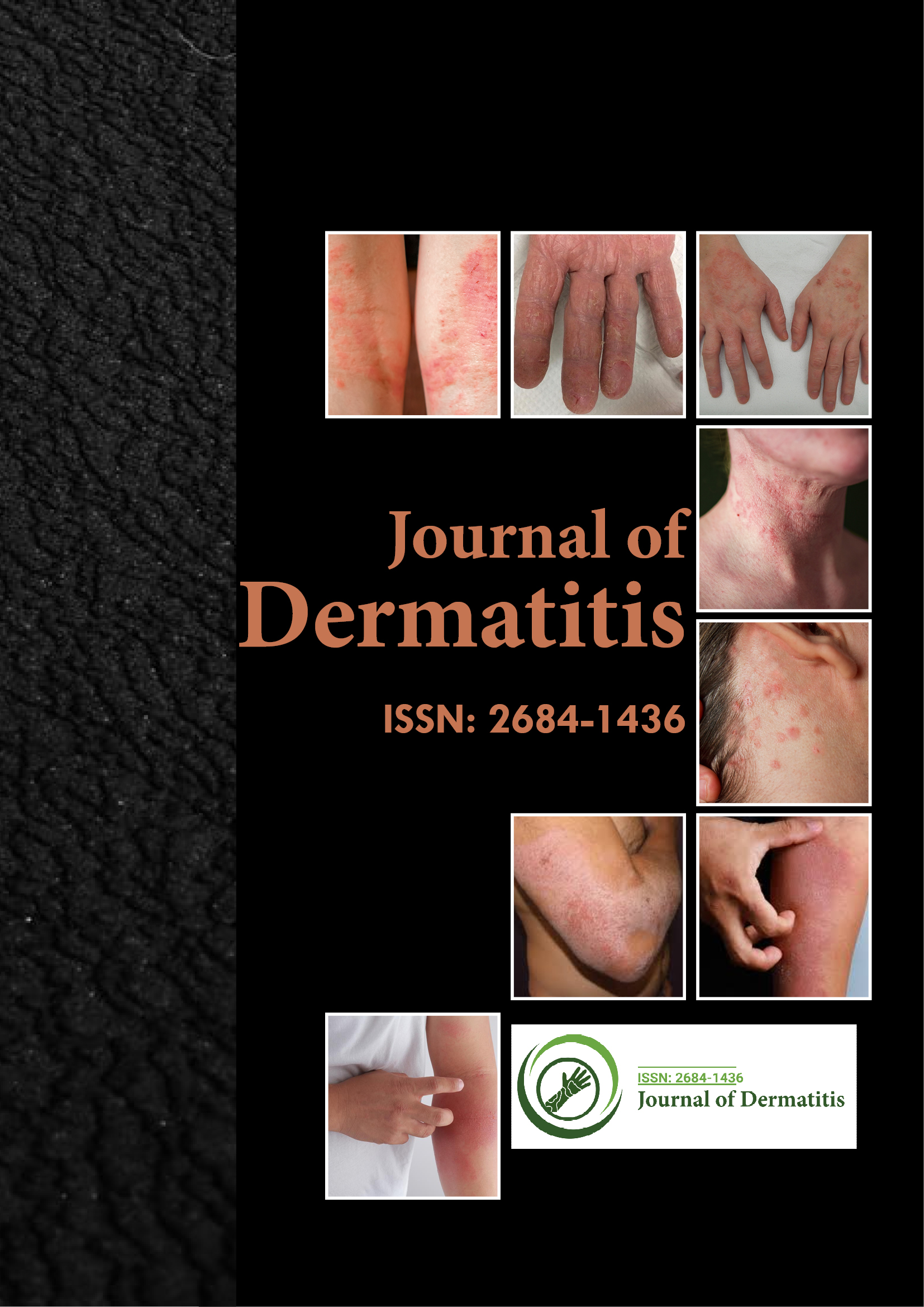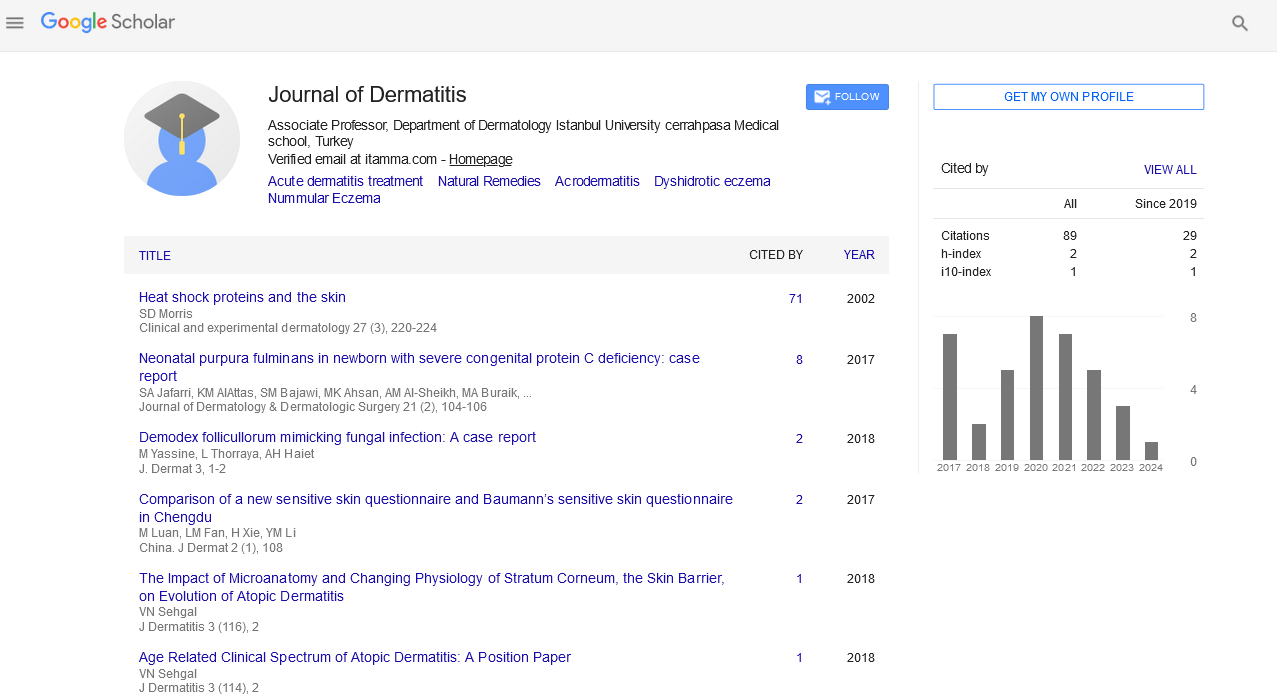Indexed In
- RefSeek
- Hamdard University
- EBSCO A-Z
- Euro Pub
- Google Scholar
Useful Links
Share This Page
Journal Flyer

Open Access Journals
- Agri and Aquaculture
- Biochemistry
- Bioinformatics & Systems Biology
- Business & Management
- Chemistry
- Clinical Sciences
- Engineering
- Food & Nutrition
- General Science
- Genetics & Molecular Biology
- Immunology & Microbiology
- Medical Sciences
- Neuroscience & Psychology
- Nursing & Health Care
- Pharmaceutical Sciences
Commentary - (2025) Volume 10, Issue 1
Role of Microbiome in Dermatitis Pathogenesis
Armaan Khan*Received: 18-Jan-2024, Manuscript No. JOD-24-24647; Editor assigned: 23-Jan-2024, Pre QC No. JOD-24-24647 (PQ); Reviewed: 06-Feb-2024, QC No. JOD-24-24647; Revised: 06-Jan-2025, Manuscript No. JOD-24-24647 (R); Published: 13-Jan-2025, DOI: 10.35248/2684-1436.25.10.262
Description
Dermatitis, a broad term encompassing various inflammatory skin conditions, has been the focus of extensive research to unravel the intricate factors contributing to its pathogenesis. Among these factors, the role of the skin microbiome has emerged as a key player in understanding the complexities of dermatitis development and exacerbation. The human skin, a dynamic and complex organ, harbours a diverse community of microorganisms collectively known as the skin microbiome. Recent scientific investigations have reveal some information on the intricate process between the skin microbiome and dermatitis, revealing its significant influence on disease pathogenesis.
The skin microbiome, consisting of bacteria, viruses, fungi, and other microorganisms, forms a symbiotic relationship with the human host. This dynamic ecosystem plays a important role in maintaining skin homeostasis, contributing to barrier function, immune modulation, and protection against pathogens. However, disruptions in the delicate balance of the skin microbiome have been implicated in the pathogenesis of various dermatitis conditions.
In atopic dermatitis, one of the most common forms of dermatitis, alterations in the composition and diversity of the skin microbiome have been extensively studied. Individuals with atopic dermatitis often exhibit a reduced microbial diversity, with an overabundance of Staphylococcus aureus, a bacterium commonly found on the skin but in elevated levels in those with dermatitis. The overgrowth of Staphylococcus aureus is associated with increased skin inflammation and the severity of atopic dermatitis symptoms.
Moreover, the skin microbiome's role extends beyond bacterial communities to include fungal elements. Malassezia, a genus of yeast commonly found on the skin, has been implicated in seborrheic dermatitis and other related conditions. The interaction between Malassezia and the host's immune system can trigger inflammatory responses, contributing to the development and exacerbation of dermatitis.
In dermatitis, disruptions to the skin barrier compromise its protective function, leading to increased susceptibility to irritants, allergens, and microbial colonization. This breakdown in barrier integrity creates an environment conducive to inflammation and the development of dermatitis lesions. Research suggests that the skin microbiome actively participates in supporting the skin barrier, and dysbiosis an imbalance in microbial communities can contribute to barrier dysfunction observed in dermatitis.
The intricate relationship between the skin microbiome and dermatitis extends beyond mere microbial abundance to include functional aspects. Commensal microorganisms play a role in immune modulation, influencing the skin's immune responses. Imbalances in the skin microbiome can disrupt this immunomodulatory function, contributing to the hyperactive immune responses observed in dermatitis.
Recent studies have highlighted the role of specific microbial products and metabolites in modulating immune responses in the skin. Short-Chain Fatty Acids (SCFAs), produced by certain bacteria, have been shown to exert anti-inflammatory effects and promote the development of regulatory T cells, which play an important role in immune tolerance. Dysbiosis in dermatitis may alter the production of these immunomodulatory molecules, exacerbating inflammation and contributing to the chronic nature of the condition.
The skin microbiome's involvement in dermatitis is not limited to atopic dermatitis; other forms of dermatitis, such as contact dermatitis, also exhibit alterations in microbial communities. Contact dermatitis, often triggered by exposure to allergens or irritants, is associated with shifts in the skin microbiome that may contribute to the inflammatory response.
Research has indicated that exposure to specific allergens or irritants can alter the skin microbiome composition, creating an environment conducive to inflammation. Understanding the interplay between environmental exposures, the skin microbiome, and immune responses is important in deciphering the intricate mechanisms underlying contact dermatitis.
While much progress has been made in reveal the complex relationship between the skin microbiome and dermatitis, several questions remain unanswered. The bidirectional nature of the interactionâ??where dermatitis influences the microbiome, and the microbiome influences dermatitisâ??adds layers of complexity to the understanding of disease pathogenesis.Conclusion
The role of the skin microbiome in dermatitis pathogenesis is a multifaceted and dynamic interplay that extends beyond the traditional understanding of skin health. Alterations in microbial composition and function contribute to the development and exacerbation of dermatitis, reflecting the complex relationship between the host, the environment, and the skin microbiome.
Citation: Khan A (2025) Role of Microbiome in Dermatitis Pathogenesis. J Dermatitis. 10:262.
Copyright: © 2025 Khan A. This is an open access article distributed under the terms of the Creative Commons Attribution License, which permits unrestricted use, distribution, and reproduction in any medium, provided the original author and source are credited.

